The Hero 8 Black is the latest offering from GoPro. It’s a fairly modest upgrade over last year’s Hero 7 with improved image stabilisation, convenient video presets and a new frameless mounting system.
But in reality, most of us aren’t upgrading their action cameras every year so I’m interested to find out how it compares to the now three year old GoPro Hero 5. There’s a new processor, far superior image stabilisation, a 60 FPS 4K mode plus a host of other new features, but there’s also one new “feature” that is actually a significant downgrade and might just put you off upgrading all together!
In no particular order I’ll cover 10 reasons it may be time to upgrade to the latest and greatest Hero 8 Black, as well as that one reason you might want to wait off!
1. Image stabilisation & video quality

The Hero 5 first introduced electronic image stablisation to the GoPro line-up, but the results were not particularly impressive. Two years on the Hero 7 much improved on this initial effort with Hypersmooth. And the Hero 8 now has Hypersmooth version 2. I’ve always been unsure just how good electronic image stabilisation could be, but it’s hard not to be impressed with this latest iteration.
It’s a decent step up from the Hero 7 and a giant leap from the Hero 5. Without a gimbal, action footage from the Hero 5 and previous models was often difficult to watch, despite all of GoPro’s marketing videos showing otherwise.

Enabling image stabilisation does crop into the video frame by around 10% and even tighter in the even smoother Boost mode, but you have a wide field of view to begin with, so the 10% crop is negligible. The tighter crop of Boost mode might not be that significant either depending on what you’re filming.
You will need good light for the best image stabilisation and although much improved over previous models, all stabilisation methods aren’t available in all capture modes which is a little frustrating and can get confusing. Hypersmooth 2.0 High mode is usually the best option with its new improved image stabilisation over the Hero 7, whilst still impressively maintaining the 10% crop. But you can’t use this in many of the higher frame rate slo-mo modes like 4K 60FPS or 2.7K 120FPS. And you lose Boost in these modes too.
So you still have to make choices. If you want the best image stabilisation, with the option to slow down your footage AND maintain a decent resolution, 2.7K at 60FPS is probably your best option.
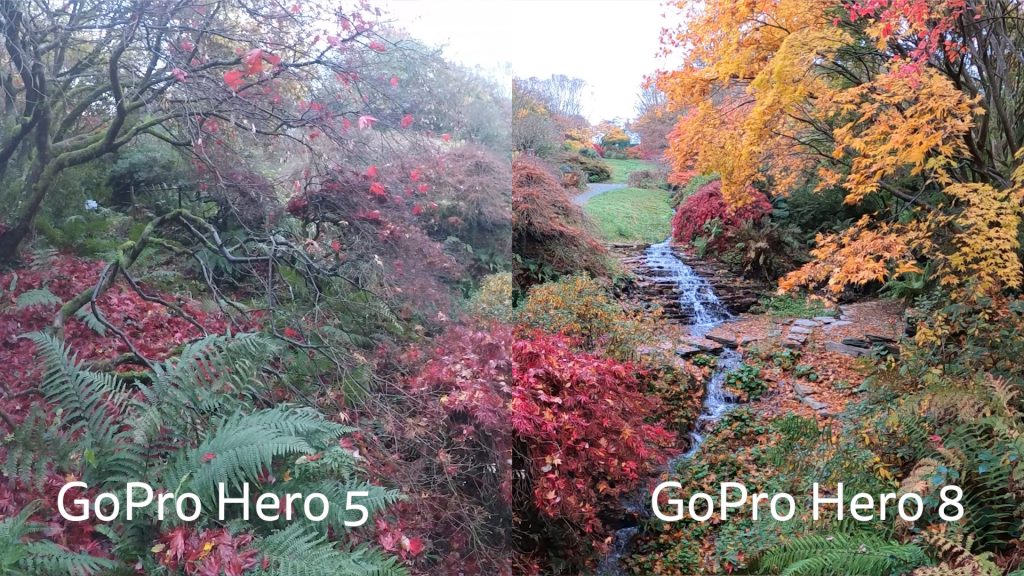
The much improved image stabilisation makes the image quality much better overall for most real world usage scenarios. They’ve also improved the colour rendition over previous models. It’s more saturated which some won’t like, but generally the resulting videos without any customisation are pleasing to most people, who aren’t going to bother with any colour correction after the fact. You can still use the camera’s Protune settings to turn off GoPro colour, and reduce contrast and sharpening if you do prefer to colour correct in post.
2. New frameless design

The Hero 5 was the first model that was waterproof without any housing, with a completely new design. There’s only been subtle design changes since then and the Hero 8 Black is the first camera with any significant change.

It still looks pretty similar at first glance, just slightly bigger. But you no longer need a frame to mount it in any of GoPro’s accessories. The mount is built into the bottom of the camera, in the form of folding fingers, held magnetically in place when not in use.

It makes using the camera much more convenient. You don’t have to remember to take the frame with you, but moreover it was always a faff having to take off the frame to access the battery and memory card. Now, there’s one side compartment that’s released with a stiff latch, revealing the battery, memory card and USB-C charging port. It’s now so much quicker changing the battery or removing the memory card.

You do lose the HDMI output, which isn’t a big deal for me, and the door although designed to come off, seems to become detached far too easily. That’s okay when you’re at home, but if you’re swapping batteries when you’re out and about it’s easy to lose and it leaves the whole side of the camera exposed to the elements. A replacement door is available but costs £20 or $20.
Removing the memory card seems harder than ever. I find it easier to remove the battery before removing and reinserting the microSD card.

The mounting folding fingers are also replaceable should you manage to break them. There is noticeable flex in the mount if you don’t have the thumbscrew sufficiently tight.
This new design also allows new Mods as GoPro call them, that expand the capabilities of the camera with a video light, a forward facing display and a directional microphone.

You do lose some protection though – the frame provided a substantial lip around the back that offers some protection to the LCD touch screen. It might be wise to invest in the Protective Housing for certain activities, but that’s expensive and results in poor audio.
3. Presets & shortcuts
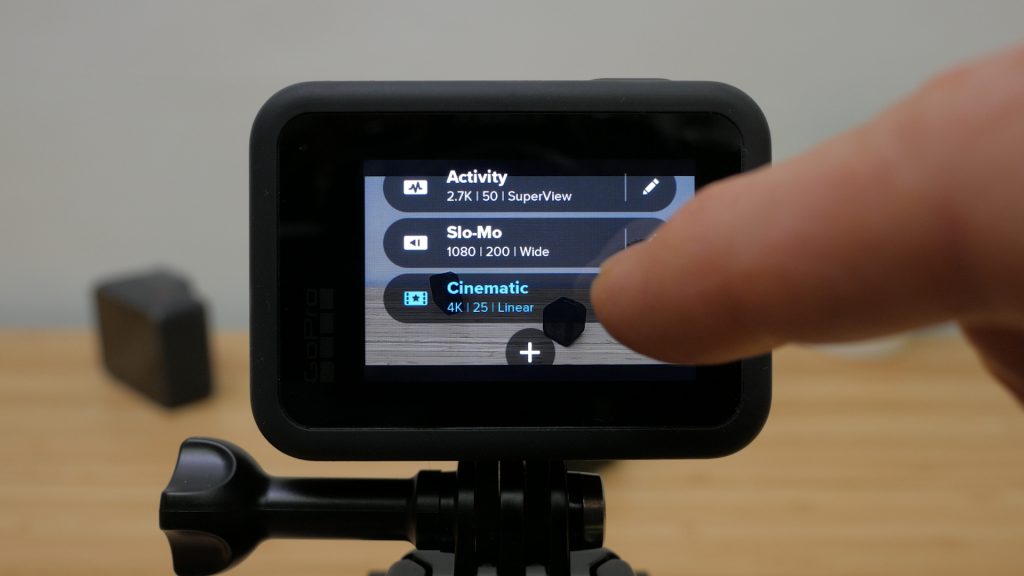
It doesn’t seem like a big deal, but GoPro has finally introduced presets like on DJI’s Osmo Action, to quickly change capture modes and accompanying settings. There are a huge combination of resolutions, frame rates, image stabilisation modes, Protune customisation options and field of views or digital lenses as GoPro now calls them. The camera now comes with some included presets, which is handy for getting started.

But you easily modify these or create your own entirely new presets. And it’s pretty easy to reset them to their defaults if you start playing around with them.

There are also customisable shortcuts that show up on the image capture screen. So you can quickly turn on Slo-Mo to increase frame rate to slow down later. Or adjust the field of view with the digital lens slider. And you can turn Boost mode on if you need a little extra stabilisation at the expense of a tighter crop.

You can quickly change the shortcuts by holding your finger down on the one you want to configure and then scrolling down the list with your finger to pick the option you’re after, which is easier said than done. You can also configure the on-screen shortcuts from the preset menu.

There are still some a couple settings hidden away. Most bizarrely the option to change framerate from NTSC to PAL is tucked away under Preferences | General | Anti-Flicker. I like to have all my cameras set to PAL frame rates that are a multiple of 25 FPS rather than the default NTSC’s multiple of 30 FPS mostly used in North and South America and Japan.
4. 100Mbps high bitrate mode

In 2.7K and 4K modes you now have a high bitrate setting that bumps the bitrate to 100Mbps, matching the DJI Osmo Action. In comparison, the Hero 5 shoots at 60Mbps and the Hero 7 at 78Mbps. This is a significant jump from the Hero 5 but not a particularly big jump from the Hero 7. The higher bit rate is particularly useful if you’re going to edit your footage. It’s also noticeable for fast moving shots, although I’m not sure you’ll be able to see the difference in the above video by the time YouTube has compressed it.

The low bitrate mode drops the frame rate back to the Hero 5’s bitrate, and is handy if you’re going to share your clips without any editing – the smaller file size also saves on storage space. If you’re going to change bitrate on the fly, you can add a shortcut. Otherwise the setting is a little hidden away in the Protune settings of your preset.
5. Photo quality

Although the same 12MP resolution as the Hero 5, photo quality is far better. Images are perhaps a little too vibrant by default with vivid colours, but like the default video settings they’re perfect for sharing without any further interaction. And you can still choose more conservative settings or even shoot in RAW mode for the most control.

There’s also the Superphoto mode which is basically an intelligent auto mode, that attempts to determine the best image processing to apply to a shot. So for a high contrast image, it might use the HDR option, combining several shots with varying exposures into one ideally perfectly exposed photo.

It is slow developing the shot, but I’ve had some good results, particularly with landscape photos. And the extra wide angle lens has gained wider appeal recently with Apple and others including a similar lens on their smartphones. I’d recommend changing the default preset to use the Linear digital lens unless you like the fisheye look.
6. Improved Slo-Mo modes

The Hero 5 Black could only shoot 4K video at 30/25 FPS. All models succeeding it including the Hero 8 upped this to 60/50 FPS, which does allow for SOME slow motion to half speed. At 2.7K you can now shoot at up to 120/100 FPS for quarter speed slow motion versus half on the Hero 5. For super slow motion you can shoot at 1080p up to 240/100 FPS which you could slow down to one eighth of the speed, although you’ll need plenty of light for decent quality. The Hero 5 Black was again half this frame rate.

Together with the image stabilisation, you can get some really useful slow motion footage with this latest GoPro, compared to the Hero 5. And I like that you can now play back the footage slowed down from the camera itself, as well as via the GoPro app.
7. GoPro app & faster download speeds
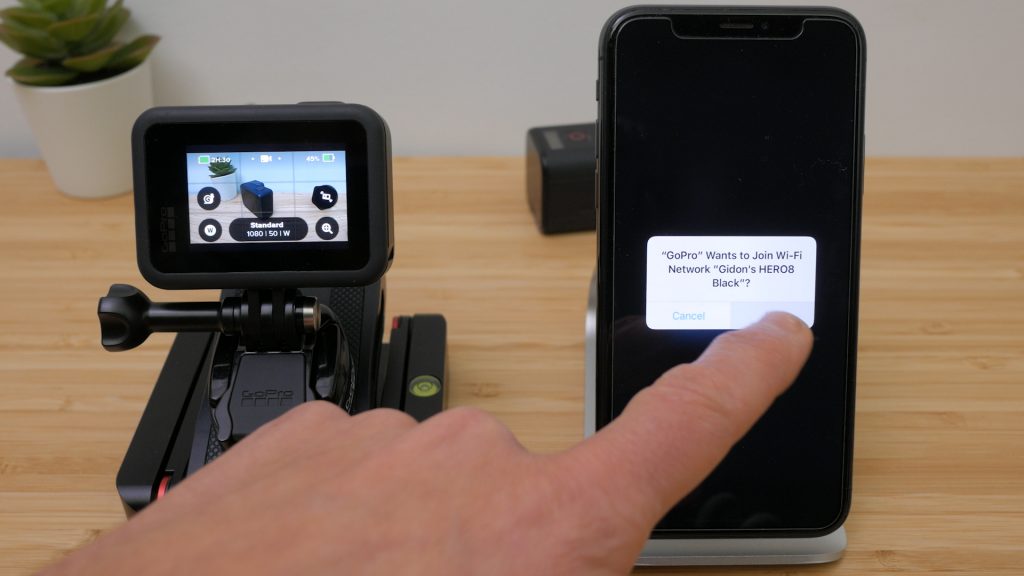
The GoPro app on iOS and Android works pretty much as it did with the Hero 5. It’s useful for controlling the camera and transferring media across for sharing or basic editing.

It’s still a little slow connecting to the camera, and it still occasionally needs a couple of attempts. But there is one significant improvement with most recent cameras since the Hero 5 including the Hero 8. They now support 5GHz transfer speeds. Transferring a 1 minute 4K file almost half a GB in size took 2 minutes 17 seconds from the Hero 5. This same file took just 48 seconds – almost 3 times as fast. It makes using the app a much better experience overall.
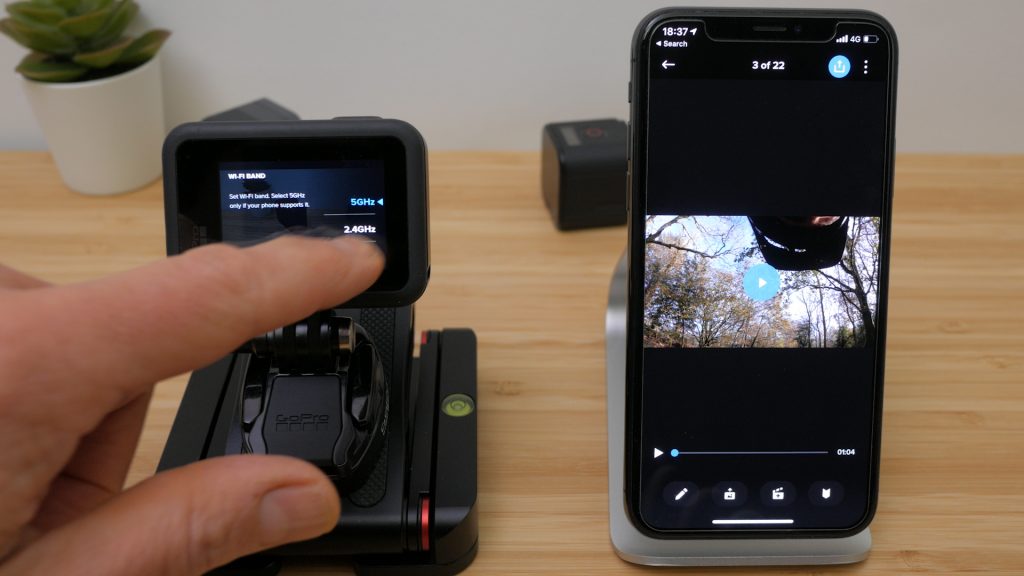
Not all smartphones and tablets support 5GHz, so if you have any problems connecting to the Hero 8, try switching to 2.4GHz under Preferences | Connections | WiFi Band.

There’s a new Horizon Levelling feature that only works on Hero 8 footage, which attempts to dynamically adjust skewed footage – it seems to work pretty well.

The app is the easiest way of adding gauges to your videos for speed, elevation, GPS path etc, so long as you had GPS turned on for the recording.
Unfortunately the GoPro Quik app for Windows is not so good. It’s not able to playback the latest 4K HEVC recording smoothly, even on a top spec’d computer. And files that have GPS data and I could add gauges to on the mobile app, display a message that GPS wasn’t switched on so it’s not possible add gauges in the desktop app. It’s disappointing, but hopefully an update will fix both issues. The only reason I have the desktop installed is to get files off the camera which then upload automatically to GoPro Plus, their unlimited cloud storage offering which I’m currently testing.
8. Improved audio
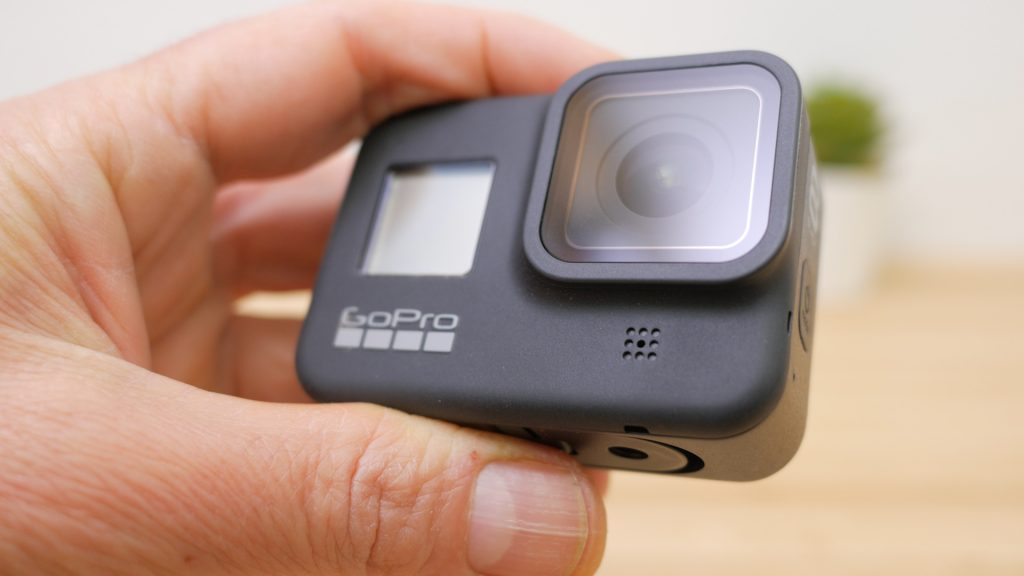
Audio off the new GoPro has been improved – it’s clearer with less background hiss. And there’s a new front facing microphone which has been designed to reduce wind noise and seems to do a pretty decent job. And you now have the option of adding the Media Mod which includes a directional microphone and a 3.5mm jack for plugging in any mic of your choosing.
You can still use the expensive USB-C external mic adaptor to plug in your own mic too, but it’s cumbersome and exposes the whole side of the camera.
9. New capture modes

The Timewarp feature, introduced in the Hero 7, is quite good fun. It combines timelapse recorded footage with Hypersmooth image stabilisation. The new Timewarp 2.0 in the Hero 8 now has an auto speed setting which makes it much easier to use. You don’t have to think about settings, you can just hit record. And there’s a Real Time button that you can tap on-screen to slow down a section of the video to real time. We’ll see how much I actually use this feature, but the results do look good.

The new LiveBurst mode is also interesting and works like Live Photos on Apple smartphones and 4K modes on some cameras like my Panasonic G80. It captures frames 1.5 seconds before and after you press the shutter. And you can then select the frame you want to use from 90 resulting frames. By default this is set at 8MP, which is basically capturing a frame from a 4K video. But you can increase this resolution to 12MP.

You can now also capture in portrait mode which is handy for quickly sharing with Instagram that favours portrait videos. Both videos and photos will be rotated and the on-screen icons switch accordingly.

Finally you can now live stream via the GoPro app to YouTube and Facebook at 1080p – the Hero 7 introduced this feature but only at 720p.
10. GP1 chip

After the Hero 5, GoPro introduced their own GP1 processor to their camera line up. This is still the same processor in the latest Hero 8 Black, three generations on so it’s getting a little long in the tooth.
But it does allow for the impressive image stabilisation and many of the other new features in the more recent cameras. Moving around menu screens is also far quicker; it’s still a bit clunky but far better than the Hero 5.
Why you might want to keep your Hero 5

Aside from saving some money, if there’s one reason not to upgrade to the latest camera it’s the new integrated lens. You could easily replace the removable lens on previous models for around £20 or $20. GoPro claim the new lens is twice as tough, but we’ll have to see about that. You’ll now need to send it back to GoPro to repair. I don’t know how much that will cost, but it’s not the greatest solution.
They are hoping you’ll subscribe to their GoPro Plus subscription for £5 or $5 per month which includes two camera replacements per year. What’s slightly hidden away in the small print is that there is still a $80 fee for this service! There are other benefits to the GoPro Plus subscription like unlimited cloud storage and 50% off some accessories, but a relatively cheap lens replacement was a much cheaper and straightforward solution.
Conclusions
There have been some big changes since the three year old GoPro Hero 5 Black, but the only feature really worth the upgrade, for me at least, is the image stabilisation. Most of the other upgrades all fit into the “nice to have” category, although a lot of them do make the new camera more enjoyable to use.
If you’re not specifically using the camera for action sports, but just as a general go-everywhere rugged camera, it’s probably not worth the upgrade cost. You can get some great results with the older model. You still get the 4K 30 FPS resolution that’s been around since the Hero 4 Black, and you can lower the resolution to get slow motion footage. Plus it’s a breeze to replace the lens if the need arises.
I can’t help but think that a few of the new features in the Hero 8 Black could have been added via a software update, like presets and shortcuts. Even more so if you’re thinking about upgrading from the Hero 6 or later. All these models have the same, now three year old GP1 chip. At least big name smartphone manufacturers tend to update the processing power with the release of a new model.
If you want the improved image stabilisation, you could also consider the Hero 7 Black which is a little cheaper, or the DJI Osmo Action at around the same price.
Still for a little extra, the Hero 8 Black does have the new frameless design which together with the further improvements to image stabilisation, do make it a very useful all round rugged camera.
Don’t forget to take a look at my YouTube video at the top of the page, and subscribe to my YouTube channel where I’m releasing videos every week on the latest technology and how to get the most out of it. If you tap the bell icon when you’re subscribe you’ll get a notification as soon as I release a video, and there’ll be a link to my site here for the written article. YouTube is also the best place to leave a comment. I read all of them and respond to as many as I can!
GoPro Hero 8 Black: https://amzn.to/32tcnJk
GoPro Hero 7 Black: http://geni.us/mAv0
GoPro Shorty: https://amzn.to/37dh0ui
GoPro Protective Housing: https://amzn.to/2CL73GC
Leave a Reply